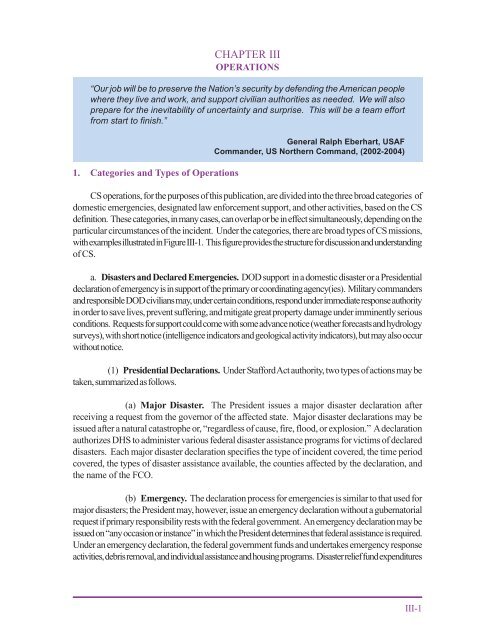JP 3-28, Civil Support - Federation of American Scientists
JP 3-28, Civil Support - Federation of American Scientists
JP 3-28, Civil Support - Federation of American Scientists
Create successful ePaper yourself
Turn your PDF publications into a flip-book with our unique Google optimized e-Paper software.
CHAPTER III<br />
OPERATIONS<br />
“Our job will be to preserve the Nation’s security by defending the <strong>American</strong> people<br />
where they live and work, and support civilian authorities as needed. We will also<br />
prepare for the inevitability <strong>of</strong> uncertainty and surprise. This will be a team effort<br />
from start to finish.”<br />
1. Categories and Types <strong>of</strong> Operations<br />
General Ralph Eberhart, USAF<br />
Commander, US Northern Command, (2002-2004)<br />
CS operations, for the purposes <strong>of</strong> this publication, are divided into the three broad categories <strong>of</strong><br />
domestic emergencies, designated law enforcement support, and other activities, based on the CS<br />
definition. These categories, in many cases, can overlap or be in effect simultaneously, depending on the<br />
particular circumstances <strong>of</strong> the incident. Under the categories, there are broad types <strong>of</strong> CS missions,<br />
with examples illustrated in Figure III-1. This figure provides the structure for discussion and understanding<br />
<strong>of</strong> CS.<br />
a. Disasters and Declared Emergencies. DOD support in a domestic disaster or a Presidential<br />
declaration <strong>of</strong> emergency is in support <strong>of</strong> the primary or coordinating agency(ies). Military commanders<br />
and responsible DOD civilians may, under certain conditions, respond under immediate response authority<br />
in order to save lives, prevent suffering, and mitigate great property damage under imminently serious<br />
conditions. Requests for support could come with some advance notice (weather forecasts and hydrology<br />
surveys), with short notice (intelligence indicators and geological activity indicators), but may also occur<br />
without notice.<br />
(1) Presidential Declarations. Under Stafford Act authority, two types <strong>of</strong> actions may be<br />
taken, summarized as follows.<br />
(a) Major Disaster. The President issues a major disaster declaration after<br />
receiving a request from the governor <strong>of</strong> the affected state. Major disaster declarations may be<br />
issued after a natural catastrophe or, “regardless <strong>of</strong> cause, fire, flood, or explosion.” A declaration<br />
authorizes DHS to administer various federal disaster assistance programs for victims <strong>of</strong> declared<br />
disasters. Each major disaster declaration specifies the type <strong>of</strong> incident covered, the time period<br />
covered, the types <strong>of</strong> disaster assistance available, the counties affected by the declaration, and<br />
the name <strong>of</strong> the FCO.<br />
(b) Emergency. The declaration process for emergencies is similar to that used for<br />
major disasters; the President may, however, issue an emergency declaration without a gubernatorial<br />
request if primary responsibility rests with the federal government. An emergency declaration may be<br />
issued on “any occasion or instance” in which the President determines that federal assistance is required.<br />
Under an emergency declaration, the federal government funds and undertakes emergency response<br />
activities, debris removal, and individual assistance and housing programs. Disaster relief fund expenditures<br />
III-1

















